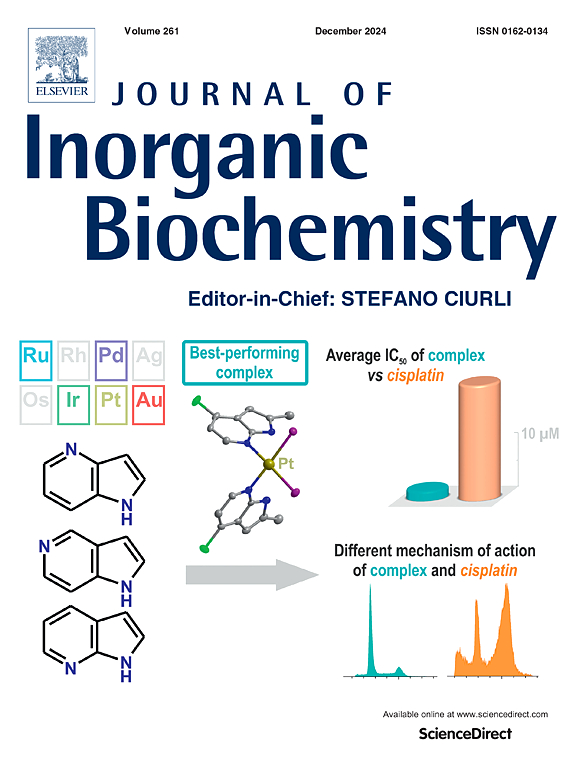含聚氧乙烯侧链Zn(II)酞菁在恶性黑色素瘤和结直肠癌细胞系中的光动力学活性
IF 3.2
2区 化学
Q2 BIOCHEMISTRY & MOLECULAR BIOLOGY
引用次数: 0
摘要
光动力疗法(PDT)是一种通过将靶区暴露在给定光敏剂(PS)光谱内波长的光下,激活细胞凋亡作为细胞死亡的首选途径的治疗方式。本研究旨在研究被4个(np-O-ZnPc1和np-S-ZnPc1)或8个(np-O-ZnPc2和np-S-ZnPc2)三乙烯单甲基乙二醇取代的非外周酞菁锌的抗癌机制,并系统地比较杂原子和取代基数的影响。与未取代的Zn(II)-酞菁(ZnPc)的比较表明,用ZnPc取代三乙烯单甲基乙二醇倾向于提高单线态氧产率,而降低所有化合物的荧光量子产率。此外,除np-O-ZnPc2外,荧光半衰期均增加。这些化合物对结直肠癌(HCT116)、恶性黑色素瘤(SH-4)和皮肤角质形成细胞系(HaCaT)的细胞毒性进行了评估。确定最佳孵育时间和光照剂量,计算各细胞系最大半数抑制浓度(IC50)。检测细胞程序性死亡途径、线粒体功能和趋化因子受体蛋白表达。这些化合物显著降低了两种癌细胞系的细胞活力,促进了细胞凋亡。从结构上看,含氧杂原子的化合物比含硫杂原子的化合物具有更高的抗癌活性。观察到PDT导致CCR7和CXCR4蛋白的增加,这表明需要进一步详细评估PDT和所提供的酞菁对癌细胞侵袭和迁移特性的影响。本文章由计算机程序翻译,如有差异,请以英文原文为准。

Photodynamic activity of Zn(II) phthalocyanines containing polyoxyethylene side chains in malignant melanoma and colorectal cancer cell lines
Photodynamic therapy (PDT) is a treatment modality that activates apoptosis as the preferred pathway of cell death by exposing the target area to light of a wavelength within the spectrum of an administered photosensitizer (PS). Here, we aimed to investigate the anticancer mechanisms of non-peripheral zinc phthalocyanines substituted with either four (np-O-ZnPc1 and np-S-ZnPc1) or eight (np-O-ZnPc2 and np-S-ZnPc2) triethylene monomethyl glycol groups to compare the effects of heteroatoms and substituent number in a systematic manner. Comparison with unsubstituted Zn(II)-phthalocyanine (ZnPc) suggests that substitution of triethylene monomethylglycol with ZnPc tends to increase the singlet oxygen yield while decreasing the fluorescence quantum yield for all compounds. In addition, an increasing fluorescence half-life was observed with the exception of np-O-ZnPc2. The cytotoxicity of the compounds was evaluated on colorectal cancer (HCT116), malignant melanoma (SH-4) and a skin keratinocyte cell line (HaCaT). The optimal incubation time and light dose were determined and the half maximal inhibitory concentrations (IC50) for each cell line were calculated. Programmed cell death pathways, mitochondrial function and protein expression of chemokine receptors were examined. The compounds significantly reduced cell viability and promoted apoptosis in both cancer cell lines. Structurally, compounds with oxygen heteroatoms exhibited higher anticancer activity than those with sulfur atoms. The observation of an increase in CCR7 and CXCR4 proteins as a result of PDT highlights the need for further detailed evaluation of the effects of PDT with the offered phthalocyanines on the invasive and migratory properties of cancer cells.
求助全文
通过发布文献求助,成功后即可免费获取论文全文。
去求助
来源期刊

Journal of Inorganic Biochemistry
生物-生化与分子生物学
CiteScore
7.00
自引率
10.30%
发文量
336
审稿时长
41 days
期刊介绍:
The Journal of Inorganic Biochemistry is an established international forum for research in all aspects of Biological Inorganic Chemistry. Original papers of a high scientific level are published in the form of Articles (full length papers), Short Communications, Focused Reviews and Bioinorganic Methods. Topics include: the chemistry, structure and function of metalloenzymes; the interaction of inorganic ions and molecules with proteins and nucleic acids; the synthesis and properties of coordination complexes of biological interest including both structural and functional model systems; the function of metal- containing systems in the regulation of gene expression; the role of metals in medicine; the application of spectroscopic methods to determine the structure of metallobiomolecules; the preparation and characterization of metal-based biomaterials; and related systems. The emphasis of the Journal is on the structure and mechanism of action of metallobiomolecules.
 求助内容:
求助内容: 应助结果提醒方式:
应助结果提醒方式:


